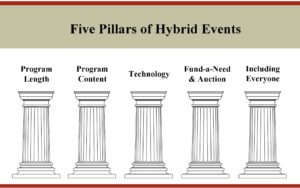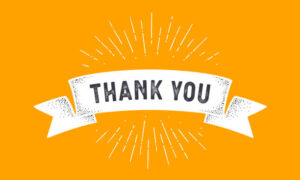Five Pillars of Hybrid Events

Written by: Kimberly Proffitt
Thinking about a hybrid event? With both in-person and virtual guests, there is a lot to consider in the planning. We believe there are “five pillars” critical to hybrid event success:
Program Length
The “shared” program should be a maximum of 40 minutes. This is enough time to conduct key fundraising elements, yet short enough to hold attention. Most importantly, the program must start on time! Falling behind schedule at the in-person event is not an option. Online viewers will be ready and waiting for the shared program to begin.
Program Content
The shared program should be mission-based. This is the time to highlight the need, show impact, and tell supporters how they can make a difference. The program elements you’ll want to include, in order, are:
- Welcome
- Mission remarks
- Fund-a-Need speaker/lead-in
- Fund-a-Need
- Live auction
- Non-fundraising elements such as entertainment, awards, and sponsor recognition
Given the short length of the program, being concise is important! Focus on your one core message and build the script around this.
Bidding Technology
The bidding platform plays a significant role in the guest experience during a hybrid event. Technology companies are working quickly to design software to make bidding and donating as seamless as possible for participants. Consider the various ways guests and viewers might choose to give or bid (for example, via mobile phone, tablet, computer, text-2-give, and even traditional bid cards). Quickly capturing bids and donations and feeding this information to your hosts will require some extra back-end work. Make sure to do some practice sessions!
Fund-a-Need and Auction Execution
Hybrid fund-a-need and auction best practices are similar to in-person or virtual-only events. For the fund-a-need, online and in-person “momentum” donors set the tone. A match can be a great motivator. Auction items – and we recommend just a few – should appeal to a wide audience. Enthusiasm is generated by spirited bidding and giving, no matter where you are watching from!
The key to hybrid execution is making sure both audiences know what is happening—and can participate in real-time. Live guests might see a thermometer on a big screen, just as online guests see the same on their TV or computer screen. The auctioneer will take bids and donations from both audiences. Having a professional auctioneer¾someone used to bids coming from all directions, keeping things moving, and creating fun for all involved¾will truly make a difference.
Including Everyone
Whether participating in-person or online, everyone should feel a part of the program and have a great experience. Welcome and thank ALL guests. When acknowledging gifts or bids, thank donors/bidders equally, whether “in the room” or online. Incorporate both in-person guests and online viewers into some of the program elements. Use different camera angles to speak to both sets of guests. Include fun elements that everyone can participate in, regardless of how they are viewing.
Our team continues to gather hybrid ideas incorporating creativity, fun, clean and easy execution, and, of course, great fundraising. Contact us to ensure all your pillars are strong and lead to a successful event!
Special thanks to team members Stacey McCurnin and Andy Imholte for providing insights for this post!
———————
Kimberly Proffitt, Research, Analysis, and Donor Engagement Consultant at Fladeboe Advancement, has worked in the nonprofit sector her entire career, focusing on fundraising and philanthropy for the past 22 years. She takes a special interest in helping organizations understand the stories data tell, strategizing on developing long-term relationships with donors, and reframing fundraising from “asking for money” to engaging with the passions and values of donors.

